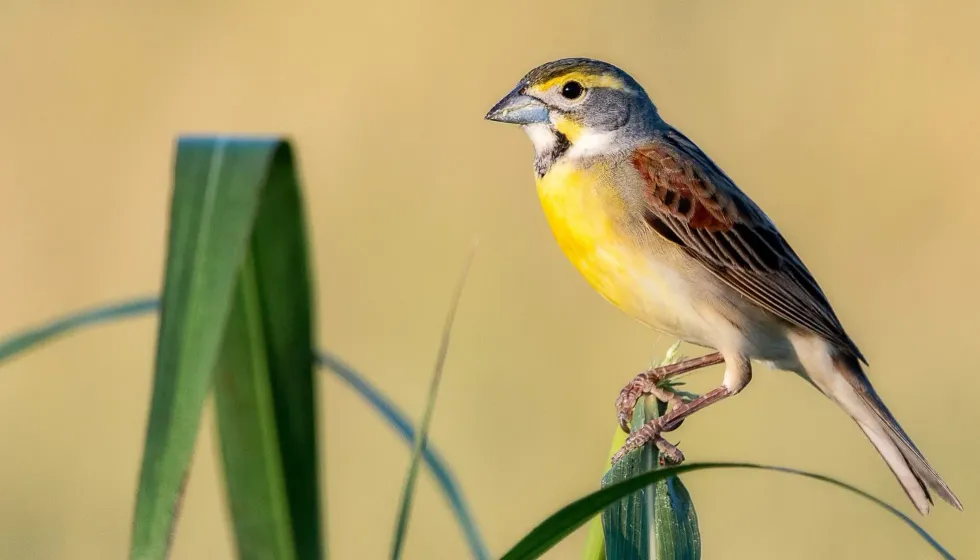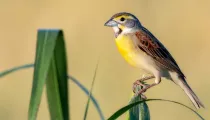Our planet is overflowing with numerous variations of organisms and flocks in North America. Though the majority of the oceans remain undiscovered, humans have been roaming on land for centuries.
We have been witnessing the beauty of nature for eons. The animal flocks talked about here belongs to the spiza genus.
The dickcissel (Spiza americana) is the only known living species of the genus. There had been sightings of a variation of flocks in 1883 known as the Spiza townsedi (also known as Townsend Finch or Townsend Bunting), named after the man who discovered this species.
Not much-focused study has been done on these animals owing to their unpredictable natures. Here are some interesting facts about the breeding and song of Spiza americana. After reading these fascinating facts about these North American birds, do check our other articles on warbling vireo facts and cinnamon teal facts as well.
Dickcissel Interesting Facts
What type of animal is a dickcissel?
Dickcissel (Spiza americana) is an animal belonging to the chordata phylum of large flocks in North America. It is classified under the class Aves, which means it is a bird and belongs to order passeriformes, family cardinalidae, and genus spiza.
What class of animal does a dickcissel belong to?
Dickcissels belong to the class of Aves, order passeriformes, family cardinalidae, and this classifies them as part of the bird family. These North American birds tend to live in large flocks with other birds of the same species.
How many dickcissels are there in the world?
As estimated in 2017, there is approximately 27 million dickcissels in the world but they have probably risen in numbers by now.
Where does a dickcissel live?
Dickcissels usually live in grasslands. This enables them to live in the prairie regions of the midwestern states of the USA, where they usually take up habitation.
These birds, from family cardinalidae, can fly as far as Central and South America. This means that these North American birds can survive in Alpine, Subalpine, tropical savannas, subtropical grasslands as well. These birds are also known to live in lightly grazed pastures, fields of hay, and agricultural fields.
What is a dickcissel's habitat?
Dickcissels' habitat is usually in nests that they themselves construct, like most other birds. Their nests are usually situated on dense grasses and hedges up to 3-4 ft (0.9 -1.2 m) high but can occasionally build them as high as 10 ft (3 m) above the ground.
The nests are built by females of the species with weeds, grasses, and twigs. The inside of the cup often has soft grass or hair.
Who do dickcissels live with?
Dickcissels (family cardinalidae) usually live in flocks only when foraging for food. These birds travel for mating and for migration in the winter. Males travel to mating spots a week before females and also forage for food during nesting.
How long does a dickcissel live?
Dickcissels (family cardinalidae) usually live an average of four years but sometimes can live longer. The oldest dickcissel that was captured was eight years old.
How do they reproduce?
The breeding range of this bird species is spread across the Central United States. Dickcissels reproduce through internal fertilization, where the egg is fertilized inside the female dickcissel bird. Male dickcissels usually mate with more than one female but never at the same time; the male waits till the nesting of one companion has begun during the breeding season.
The incubation period is of 12-13 days, after which the hatchlings remain in the nest for 7-10 days before moving out. Dickcissel babies are covered with white down when born and are fed insects by their mothers during the nestling period.
What is their conservation status?
Dickcissels are currently abundant in numbers. Their population had dropped in the 19th century, but in the present, their population is of the Least Concern.
Dickcissel Fun Facts
What do dickcissels look like?
Dickcissels have cone-shaped beaks or bills and dark eyes with a yellow breast. Their stature is small with plumage in rust, and a dark grey streak with black.
Their undersides are lighter with a yellow patch. The males have a black v-shaped bib on their throats and yellow eyebrows, both of which the females lack. The males are also a bit larger than the females in appearance.
How cute are they?
Dickcissels would remind people of birds like sparrows and meadowlarks. This species looks very cute and colorful, fit for adorning the grasslands that this bird species lives in.
How do they communicate?
Dickcissels communicate through their chirps and songs. The mating song is used by males to attract females during the breeding season. The dickcissel song sounds like "dik-dik-dik-ciss-ciss".
How big is a dickcissel?
Dickcissels have a length of 5.5-6.3 in (14 - 16 cm), including their tail. They are similar to the size of house sparrows and around 50% bigger than hummingbirds. Unlike some members, dickcissels can fly and have an average wingspan of 9.8-10.2 in (24.8 - 26 cm).
How fast can a dickcissel fly?
The speed of the dickcissel’s flight is estimated to the around 37.5 mph (60 kph).
How much does a dickcissel weigh?
Both males and females of the dickcissel species have an average weight of 0.9-1.4 oz (0.02 to 0.03 kg).
What are the male and female names of the species?
Male and female dickcissels do not have any particular name assigned to them and can be addressed simply as male and female.
What would you call a baby dickcissel?
A baby dickcissel would be called a young, nestling, or chick since they do not have a known assigned name. Migration of this bird species starts after they have attained maturity.
What do they eat?
Dickcissels feed on insects during migration like caterpillars, grasshoppers, termites, flies, and other bugs. These birds also eat spiders. Their diet consists of both seeds and insects during the mating season. In winter or in migration, this bird species only feeds on willows, grasses, seeds, cereal crops, buckwheat.
Are they dangerous?
Large dickcissels can be considered very lowly dangerous, and that too only when threatened which is common among all animals. This bird species is not aggressive unless they are protecting their territory.
Would they make a good pet?
Dickcissels have survived in the wild for a long. If this bird was to be domesticated, it would have been domesticated by now. Since large dickcissels are migratory birds and thrive as a free bird, it is advised to not bother them, for it is unlikely this bird would want to be a pet.
Did you know...
Female large dickcissels are the workers who construct the nest and usually forage for food before nesting. Males seem to live only to mate and to protect their territories.
Male dickcissels are territorial, especially during mating season. The males’ fight over territories through their songs and the males with a larger territory attract more females.
During migration, these birds gather into flocks of millions to move south.
Large dickcissels have highly unpredictable behavior when it comes to breeding. They may change their direction or place breeding very suddenly.
These birds get their name from the way their song goes: "dik-dik-dik-ciss-ciss". Dickcissel is pronounced as 'dik-si-sil'.
The dickcissel's eggs
The eggs of dickcissels are a pretty shade of pale blue and are unmarked. The usual number of eggs laid is four, but this can vary between 3-6 eggs. Almost all broods have 1-2 eggs that are empty.
The average length of the eggs is between 0.8-0.9 in (2.03 - 2.28 cm), while the width ranges between 0.6-0.7 in (1.5-1.7 cm).
Threats to the dickcissel
The major threats to these birds are predatory birds, radiation from technology, the environmental degradation brought upon by modern infrastructure and humans.
Birds like hawks and prey upon them while humans hunt them for food and due to them being considered pests. The number of dickcissels, although not of immediate concern, has still been declining in some regions.
They contribute to our ecosystem by being a part of it. We should not interrupt or cause any imbalance because it can throw off the whole picture.
Here at Kidadl, we have carefully created lots of interesting family-friendly animal facts for everyone to discover! For more relatable content, check out these palm warbler facts and tricolored heron facts.
You can even occupy yourself at home by drawing one on our songbird coloring pages.









